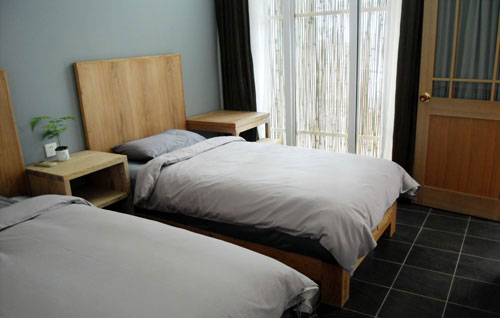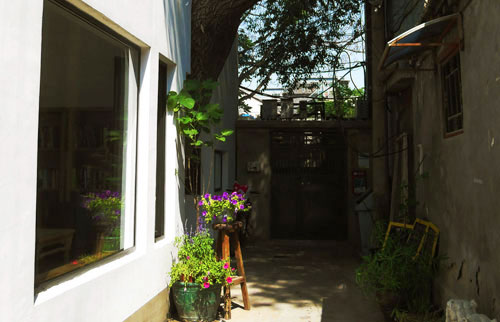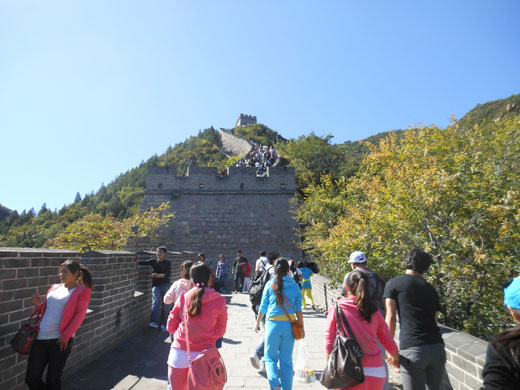Omphaloskepsis Blog
China Adventure {in a Nutshell}
Aug 20, 2013
In this post I want to take you on a quick tour of places and events that I'll be discussing in more depth in subsequent postings.This post is rich with photos for you to enjoy.
Firstly, I was extraordinarily forturnate when in came to my preparations for my trip to China. Having preceded me by 2 years, artist friend Jeff Mihalyo coached me on what to expect and what I would need to take with me. He connected me with a few friends he had made when he was there last. He gave me ideas for gifts to bring and showed me how to prepare my business card and promotional materials for China. He suggested I say in a hutong and told me about his experience with the time difference and arriving a day earlier than he expected...for which I was grateful. I knew I wouldn't make the same mistake....or would I? D'oh!
Below is a photo of the Starbucks in the Beijing International Airport, where I waited for a couple of hours for a ride to my hotel. The reason I waited is because it was the 14th, not the 15th, as I was expecting to get in! I threw everyone offguard! I was able to make arrangements with the hutong to tack on an extra night. My friend Meihua and her father picked me up in the family car. I found out they could do this because they were licensed to drive on even days. If I had gotten in on the 15th we would have taken public transit. My connection to Meihua was set up by Long Gao. A local artist who grew up in China during the cultural revolution and taught at major universities across the country. He's one of the most talented people I've ever met and prolific! He now teaches art lessons and traditional Chinese painting out of his home in Lynnwood. His wife is an uber accomplished pianist who has taught many famous students. Its been a great honor to get to know them. Meihua is one of his students that went to school in Seattle and was home in China for the summer. She now attends the Pratt Institute in Brooklyn, New York. I don't think I could have navigated China without her assistance. She taught me the transit system, got me a transit card, got me a prepaid phone and showed me around! It's difficult to need help and difficult to accept, but I knew I needed her and tried to accept assistance as graciously as possible. I can't express my gratitude, it's so great.

Below is Faith Brewitt. My dear friends, Paul and Wendy Owen of Owen Media, here in Seattle, connected me to this dynamic, brilliant, experienced, gorgeous gal. Faith has lived in Beijing for more than 15 years. She's so cool. She studied ancient Chinese literature in grad school. She said it was her and 5 old Chinese dudes, they all wondered what she was doing there but formed great friendships. She's a PR expert who was terrifically successful in the private sector. Now she's got her own business venture in China called Have Faith in Your Brand. She agreed to work with me, introducing me to some key people, setting up interviews and press junkets. Since my academic specialty is quantitative ideation, we thought I might teach some seminars to the Chinese corporate sector on effective brainstorming and innovation techniques. She worked wicked hard on this, alas it was not meant to be. I did, however, get a little press! Mostly, we had a great time! Laughing, hanging out with her and her life partner, Mike, and having experiences together. She's the kind of girl friend ever woman hopes to have in their lives.

Below is an installation view of my painting in the National Museum of China, Beijing, Naked Snow Blower. This happened at the tail end of my trip. I love watching people interact with the work, talk about it, point to it, and photograph it. It didn't do as well in transit as I had hoped and needs to be restretched at some point. The support bars I put across the back also provided some difficulty for the installers as the screws became stripped and they had to hang it with those transit bars in place. I wanted to donate this artwork to the museum, but import export laws prevented them from accepting orginal paintings, only prints. So it eventually came back to my studio. Their installers handled it beautifully and it was packaged well. I was happy to see my art on so many social websites in China after the exhibit. Here are a few of them:
http://www.takungpao.com.hk/shuhua/content/2012-10/15/content_1228849_34.htm (I love the translation of the painting title... which I had to change to Naked Snow Thrower since that's what Snow Blowers are called in China.
http://blog.artron.net/space.php?uid=610077&do=blog&id=1021757 (in this one I was honored to be included among all the Chinese artists. Many people thought that my model was Chinese.
http://www.acavcr.com/2012/11/15/pekin-2012-obras-de-diferentes-artistas-del-mundo/ (And here, a Costa Rican posting of the Biennial)
http://hxqzhangcheng.blog.163.com/blog/static/6650439020129232320742/

Recently, my Chinese Wiki page went up. I am quite excited!
When I met with Faith, she took me to a park where we had fabulous lunch! I brought her some goodies she couldn't get in China. Below are the taxi's I saw in the park. This was the tamest traffic in Beijing! more on that later.

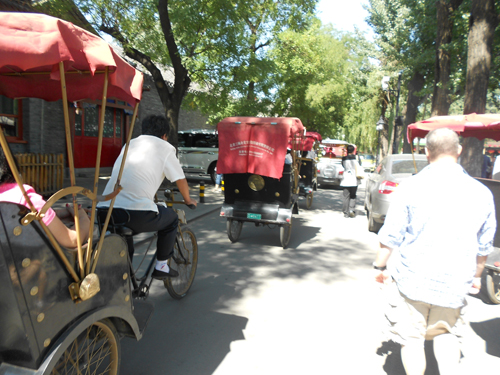
Can you see in the photo below that car coming down the street, South Luogu Lane, Gulou East Street? That's what it was like trying to drive down the street to the hugong where I stayed, in the heart of this wonderful shopping district.
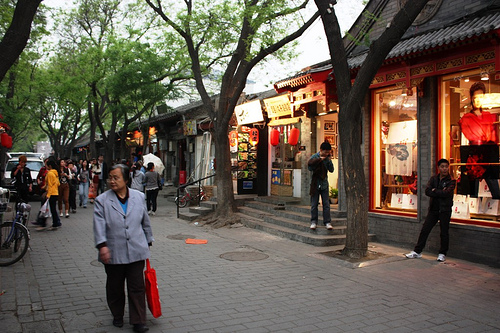
I stayed at Hutong Ren, a beautifully rennovated hutong that caters to an international crowd. It was off the beaten path, down an alley, quiet and the staff was wonderful! The food was delicious too. Hutong now means a lane or an alley, formed by rows of siheyuan (a compound with buildings around a courtyard) where old Beijing residents lived. The word "hutong" originates from the word "hottog" which means "a well" in Mongolian, in ancient times villagers dug a well and then lived around it.
Here's the experience of walking through a hutong although South Luogu Lane, Gulou East Street was wall to wall people:
Below is a video of Nanluoguxing (South Luogu Lane), where I was.
Below are some photos of Hutong Ren (I swiped them from their website, they're better than mine)

The rooms were comfortable. Although, you had to keep the sink trap closed at night and the bathroom door closed to minimize the acrid sewer gasses that came up in the night. The other thing I noticed was that my tongue was gray in the morning. It brushed off but I can only imagine, that without an industrial air filtration system, my tongue was covered with pollutants and particulates. After the second day in Beijing I developed a hacking cough and the urge to spit all the time, which I controlled, mostly because I can't project and would have ended up covered in my own gray saliva! I did begin to wonder if this was part of the reason why so many men spit in the street and out of the car windows constantly.
On the left is the entry, down a quiet alley, to Hutong Ren.
My primary purpose was to donate historical documents to the Chen Chi Museum in Shanghai and in Wuxi. I had them stored in special folders. As well I was loaded up with gifts for my various hosts. After a couple of wonderful night stays in Hutong Ren I made my way to the Beijing train station so that I could take the bullet train to Shanghai. Faith and Mike helped me get my ticket and a taxi me to the train station. It turned out to be about about an hour or more to the station from Luogo Lane. It's gorgeous architecture, is it not? I was stunned by the beauty when I finally got on the train...(dun dun dun...)

Below is what the Beijing train station train schedule sign looks like. I studied that sign for a good long time. I had to. You see, when I arrived an hour later at the train station with my bag and my gifts, just before boarding the train I realized I didn't have the historical documents with me! I had left them on the hotel counter in my haste! I then transformed into the awful stereo typical American tourist. I called the hutong to verify they had my documents. They spoke in whispered voices at the hutong, so naturally it was nearly impossible to hear them. What? Can you speak up? I'm in a train station it's noisy here and I can't hear you. What? What? What? What? The lady next to me was having her own very very very loud conversation. I became so frustrated and irritated that I yelled into my phone while looking at the lady next to me, "I can't hear you, it's too noisy here, I can't hear you over the conversation next to me!" At which point the lady next to me looked terribly embarressed and said in near perfect English, "I'm so sorry! Please excuse me." and moved away from me. I was pretty ashamed of myself. I then had to exchange my ticket for a later ticket. I texted Meihua for some translation assistance. Should I say, I woke up Meihua? I stood in the ticket line, made it to the front and leaned in for better communication. At which point no less than three people pushed me aside and started and physically squeezed their bodies in front of mine, all the while yelling at me in Chinese. I realized this was discrimination and internally I was fascinated by having this directed at me. I knew what I had to do, having my Chinese friends coach me ahead of time. I had to push back vociferously. I did it. I yelled back, told them to wait their turn and got back in place. It didn't feel good but it was the right thing to do in this circumstance. I believe I would have never resolved my issue if I kept letting it happen. I took a cab all the way back to the hotel (I couldn't even figure out how to depart the train station. I kept going out the entrance and trying to hail a cab. Finally one cab driver took pity on my and explained that I had to go to a different location to catch a cab. And kindly guard who didn't speak much English (and I knew only a little more Chinese than she knew English) walked me to the taxi pick up area. I felt like a dumb American tourist...because I was.
The train ride on the bullet train itself was smooth and beautiful It took just under 4 hours to get to Shanghai International Airport on the train. Our top speed, much reduced since an accident a few years prior, was 296 kpm. Faith told me it used to take about 2 hours to get to Shanghai at 400kpm. What I saw out the window of that train, however, was breath-taking. Beautiful coutryside, yes, but also the construction of entire new cities out in the middle of nowhere, not yet inhabited. It was amazing. In fact, there was so much construction going on everywhere all the time 24 hours a day. And in America, where we have 5 men and 20 huge machines, they had 100 men and 1 machine.
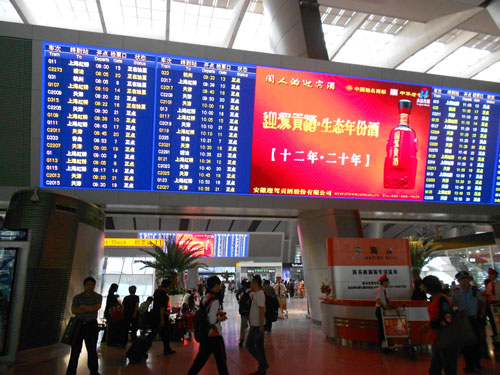
But, I got to Shanghai with all my accoutrements and made it to the Fish Bund Inn. My room was gorgeous! The location was about 5 blocks from The Bund.
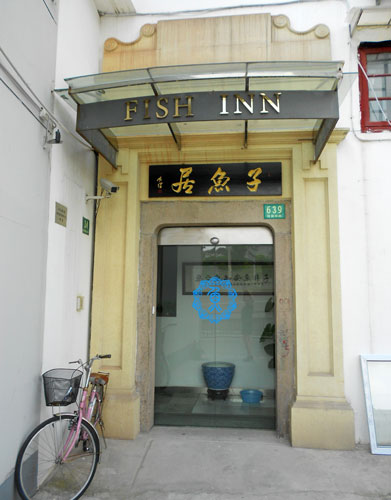
After settling in, attorney Sunny Lieu and his wife picked me up. They had a private driver. My Seattle friend Ricardo introduced me to a few of his China contacts and Sunny had been helping me for several months to locate the Chen Chi Museum in Shanghai, and set up an appointment to visit it and make this gift. Sunny's wife came along with me and acted as my interpreter. Sunny was working in Shanghai and Hong Kong. Also generously helping me was John Yu, Alice's son. Alice was Chen Chi's wife. I was introduced to John through Elizabeth Wang Gallery in NYC. John gave me the contact name and number at the Shanghai Chen Chi museum. He also gave me some important information about how to find the Wuxi Chen Chi Museum. I was very concerned about making this connection. It was a big expense and a long way to come to show up to a locked door. In the photo below is Jose Shibu. Jose is a yoga instructor in Shanghai. I had been hoping to take some classes with him but it never did pan out.
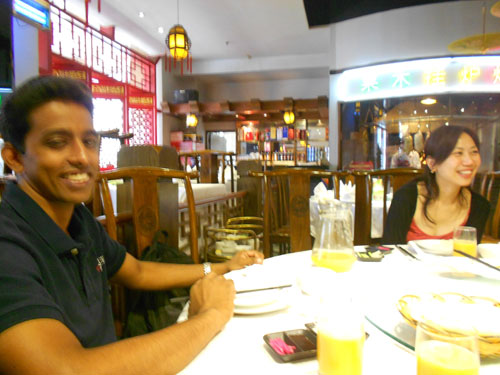
Below, in the middle, is Sunny Lieu, his wife on the left and a friend of theirs on the right. Sunny took us out for the most delicious Peking Duck before his wife and I set off for the museum. Jose ended up coming with us at my urging. I'm so glad he did, it was through him that I got one of the best photos.

One of the wonderful things were the street vendors. At night, down the street from The Fish Bund Inn was a market. It began around 10 PM when people started to get off from work. It was a lively scene and the food looked delicious. I did not sample it. .. Until I got to Chengdu...
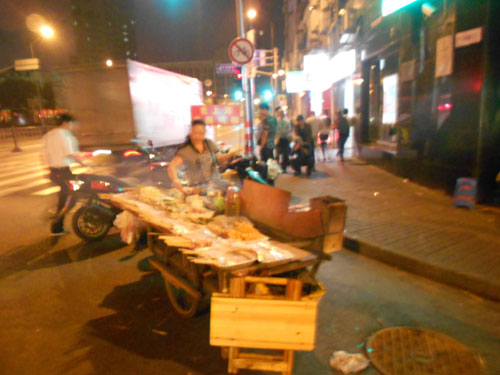
One evening Faith set me up with dinner at M on the Bund. An expats haute cuisine rooftop restaurant overlooking The Bund. I met with an incredibly dynamic business owner, Jing, who was writing apps. Later that night she took me to another part of Shanghai to show me The Himalaya, the most expensive known hotel lobby. Exquisite!
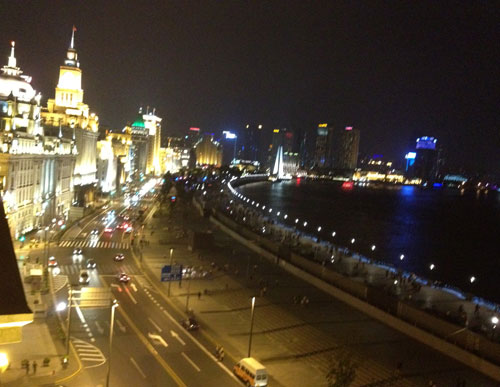

So many of the buildings in Shanghai, Wuxi, and Beijing had terrific light shows going on at night. This is the exterior of The Himalaya. The lights flashed and changed and rolled up and down the side of the building. Different colors and patterns.

The Himalaya Hotel was also host ot a dynamic convention center. Jing has consulted on this portion of the project at one time. We snuck in and took some photos.

Below is the photo of the photo that Jose Shibu took for me. It shows Alice, second from the left, Harry Vrymoet next to Alice, Famoust Chinese Artist Dai Chien, third from the right is Chen Chi and all the way to the right is wonderful Aunt Agnes, who wrote most of Chi's correspondence for him.
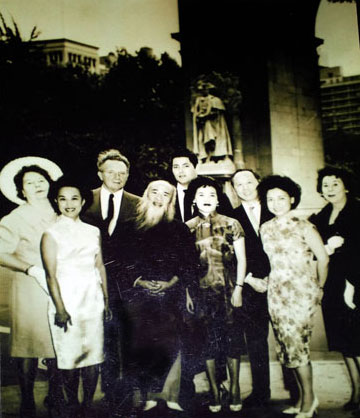
After I found the Chen Chi Museum in Shanghai and made my donation, visited the art, I traveled on to Wuxi by bullet train. Wuxi is where Chi was born. I had no idea where or how to find the Chen Chi museum there. The Shanghai Museum wouldn't assist me because their nose was out of joint over the museum and the way they felt things were mishandled. So I was on my own. What an adventure! Below is Angela Wu, my translator in Wuxi. She went with me to the Chen Chi Wuxi Museum and ended up spending the day with us. Lovely lovely girl who attends college in England and comes home for the off season to be with her family and work as an ESL teacher. Here we are getting ready to eat the world famous Wuxi dumplings. There is no place on earth that makes dumplings as wonderful as Wuxi!

After my business was completed successfully, I took a vacation. My friend C.J. Shane advised me to get out and see China. I used a special program to assist me with the intensive planning. I orchestrated my business and vacation to occur before the Biennial mainly because after the Biennial was the start of the National Holiday in October and you do NOT want to be locked in with the entire country of China on vacation at the same time, you'll never get anywhere the crowds are so thick! The upside, however, was that I had a long time to acclimatize and was pretty comfortable in China by the end of my trip. I decided to fly to Chengdu, in the Szechuan region, where the food is spicy! I wanted to have tea in one of their tea rooms, see the original SiChuan Face-Changing opera, and go and see the pandas at the Panda Reserve. I also wanted to get out in nature and climbed the peak of Emei Shan. I stayed in┬ĀI stayed at the marvelous Buddhan Zen hotel located just out side of the Wenshu Temple, in Wenshufang folk and Custom Street and near Chunxi Road Commercial Area in Chengdu, China. It was lined with outdoor antique carts and shops. This is a beautful tea shop. All of those disks are tea. I wish I had bought some.

Below is the main temple at the peak of Emei Shan. It was $30 dollars (about 200 RMB) to get a blessing in this temple. Could you imagine having to take care of those lanterns every day? Can you see them circling the base of the temple, all the way up the steps?

The next stop was the Panda Reserve. What a wonderful adventure that was! I drew, took lots of pictures, and held a baby panda! Then I managed to walk up the side of the freeway to make my way to the public bus where I paid 32 cents for a trip back to the city.
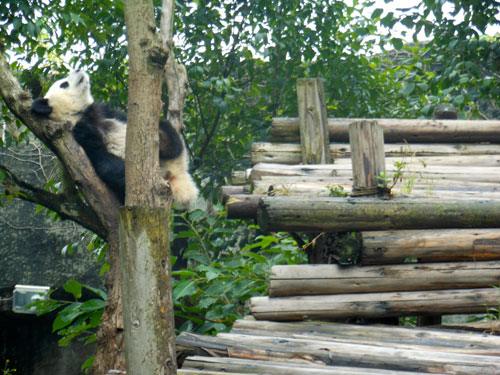
Below is one of the costumed actors from the face changing opera in Chengdu.

I returned to Beijing where I received another Peking Duck dinner at one of the most famous restaurants for this meal. So wonderful. They gave me the registration number of the duck we ate and I mailed it as a postcard.

At the end of the Biennial, I went with my friend Mansour Ciss who was from Senegal, to the Badaling portion of the Great Wall. beautiful. lots of steps. I had intended on visiting a different portion but it was the start of the national holiday and the traffic was terrible, so we went to the closest portion.
Below is a photo of me with Professor Zhang who teaches at the Tsinghua University, and his wife who works for the state in publishing, book cover design. They're connections through Long Gao. They took me for dinner, we ordered so much food but wow! it was phenomenally good! I adore Professor Zhang! He and I went to the Summer Palace and had some deep conversations about art. It turned out that he also was connected, in a roundabout way, to the new Inside Out museum, where some of the Biennial Curators were opening a the first show at this museum, including the head of his department. And his art studio is on the same grounds! I felt I really connected with him and his wife and miss them. I'd love to see them again someday.

You may also want to visit the previous China Blog: Exotic Aventures Part 1
 MENU
MENU

